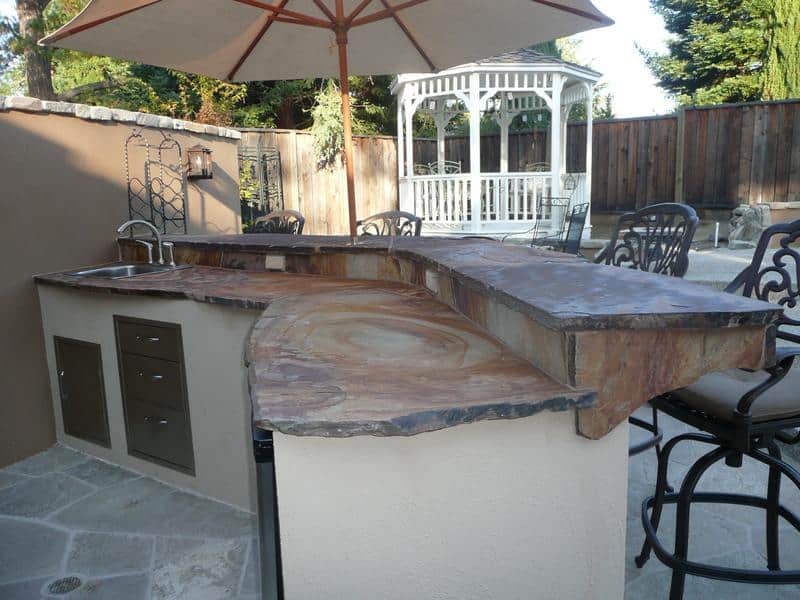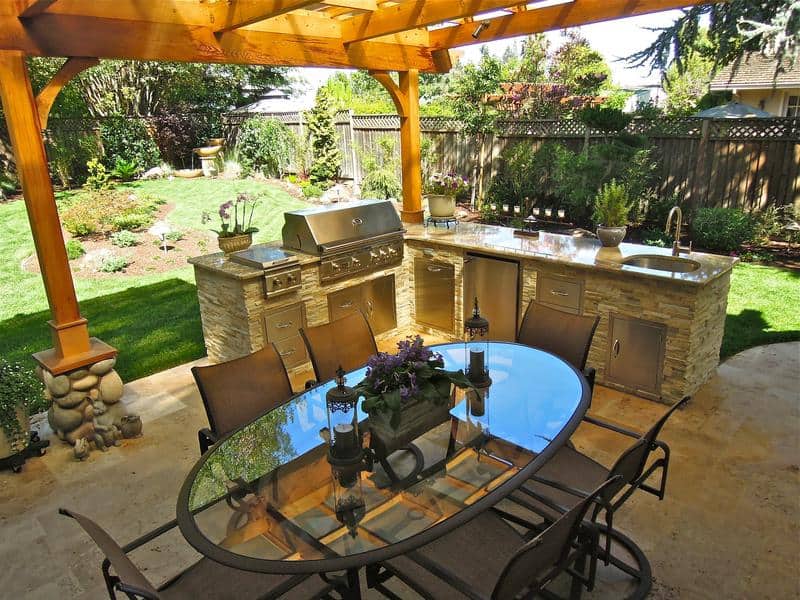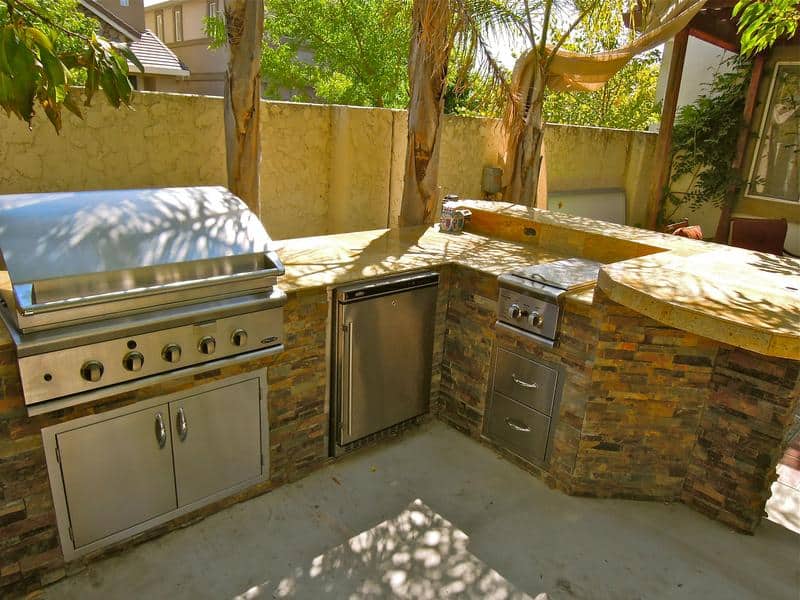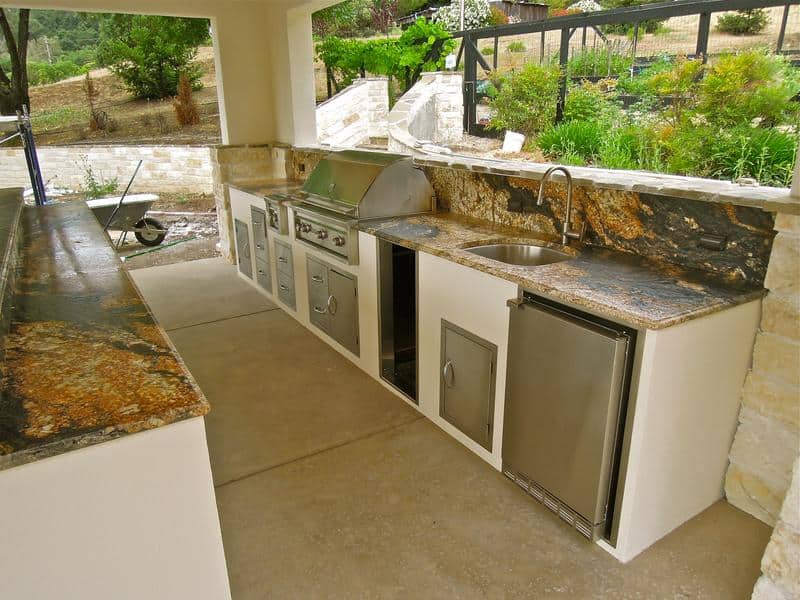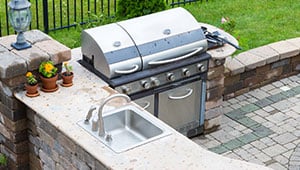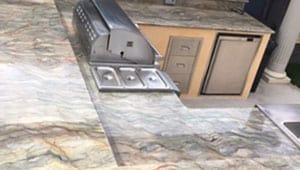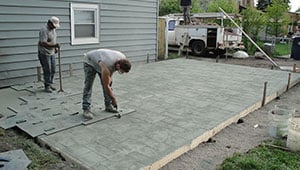
Request Your Free Estimate and Design
Custom Outdoor Kitchen Design
Are you dreaming of building your very own outdoor kitchen?
Perhaps you have a clear vision in your mind of exactly what your outdoor oasis will look like. If that’s the case, click below to start the process with us!
Or maybe you’re just ready to up your grilling game and are just starting to think through what a custom outdoor kitchen can offer you. Regardless of which group you fall into and no matter what size outdoor kitchen you’re envisioning, you’ll need a well-thought out design in order to make sure your kitchen is useable, comfortable, and affordable.
At Unlimited Outdoor Kitchen and Pavers, we’ve been designing and creating backyard kitchens in the San Jose area since 2000. We’ve seen our share of kitchens of all shapes and sizes, for every budget level and yard layout.
Here’s our guide to custom outdoor kitchen design—from the brainstorming phases to picking out finishes.
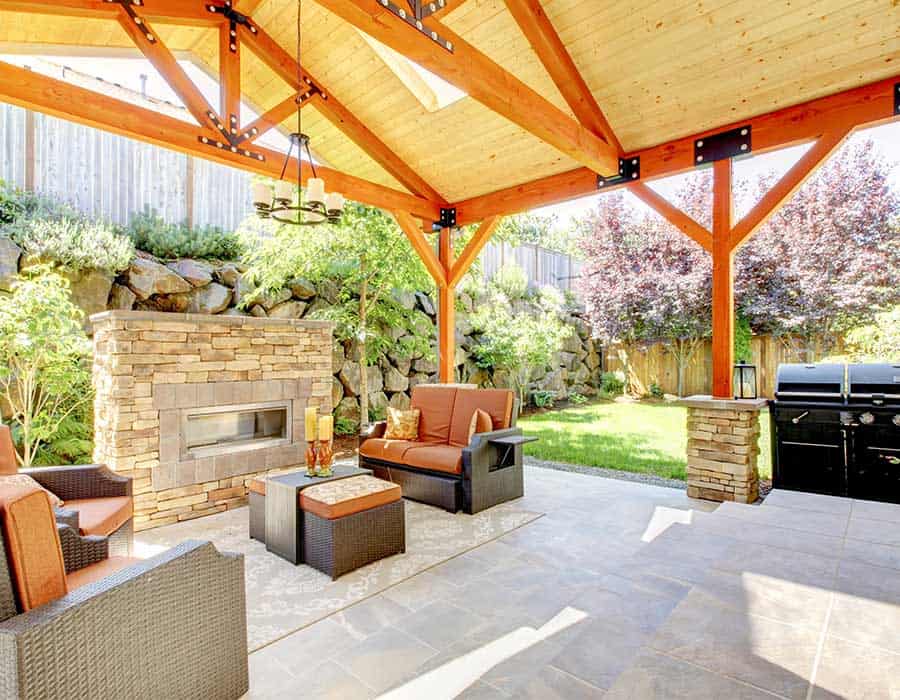
Brainstorming Stage
It’s great to gather inspiration for your kitchen from sources online or in magazines. Before you go crazy adding on every bell and whistle you see, make sure you’re designing an outdoor kitchen that’s truly custom for you.
1. Determine your entertaining style
Depending on what your goals are, the trendy kitchens you see online may not actually fit your needs, and could end up being a source of frustration. You may end up paying extra for appliances you never use, or find the layout it impractical for your entertaining style. Or you may love the look of a small kitchen, but find it cramped and insufficient over time.
The first step for designing the right kitchen for you is to honestly evaluate your outdoor entertaining goals. Ask yourself:
- How many people do you want to entertain at once?
- Do you plan to feed your guests indoors or outdoors?
- Before grilling, will you prefer to prep food indoors or outdoors?
- How often does your schedule realistically allow you to cook outdoors?
- Which outdoor cooking methods do you currently use? Are you satisfied with them, or itching to try something new?
- What will an outdoor kitchen allow you to do more of that you can’t currently do?
Scroll through our inspiration gallery below then take a look at our blog: 5 Questions to Ask Yourself Before Building an Outdoor Kitchen
2. Decide on “must-have” features
In most cases, a quality grill is the must-have feature for an outdoor kitchen, but you may have other items at the top of your list, too. What aspects of the ideal outdoor kitchen have you been dreaming of?
Make a list of things you’d love to see in your outdoor kitchen and put them in order of preference. This will help you determine which aspects of your kitchen matter the most to you, and which you can leave out of your design if necessary.
Some popular features you might consider are:
- Another cooking appliance, such as a pizza oven or barbecue smoker
- An outdoor kitchen sink
- A refrigerator or beverage chiller
- A side burner or warming drawer
- Cabinets or other storage options
- A warm gathering spot such as an outdoor fireplace, fire pit, or fire table
- A pergola for shade or to keep out the rain
3. Determine your budget
Being realistic about your budget at the outset is important for several reasons. First of all, knowing your budget going into the design stage will help you prioritize which features are most important to you. You don’t want to pour your heart into an extravagant design, only to find out you have to scrap most of it when you discover the price tag.
Secondly, you’ll want to avoid the temptation to grossly overspend on your outdoor kitchen. The whole point of an outdoor lifestyle is to relax and enjoy the results of your hard work over the years—and it’s hard to relax when you’re worried about how you’re going to pay off debts you can’t afford!
A custom outdoor kitchen is a major home renovation. It can add property value to your home in the same way, but it does require an investment.
So how much should you plan to invest in your outdoor kitchen? Well, costs depend on a large variety of factors, but a top-of-the-line grill with a surrounding barbecue island will cost at least $5,000. The price will increase as you add more appliances, counterspace, and upgraded finishes. You should expect to pay upwards of $10,000 or $20,000 for an average outdoor kitchen.
Of course, the best way to figure out precise costs is to get a professional estimate.
Designing Stage
Once you have a good idea about your goals and budgets for your outdoor kitchen, it’s time to start getting the specifics nailed down. At some point during this phase, you may want to hire a professional outdoor kitchen designer. He or she can help you avoid beginner mistakes that will add to the cost and cause frustration.
1. Evaluate your space
An outdoor kitchen should not only be customized to your entertainment style and aesthetic preferences, but also should fit harmoniously into your backyard.
When choosing a spot for your kitchen, consider the following factors:
- Available space
- Amount of sun (including whether you have a southern or northern exposure)
- Convenience to your home’s back door
- Levelness of the ground
- Potential drainage issues
- Where you can or can’t run plumbing or gas lines (if needed)
- Best view
- Amount of privacy (and whether that’s important to you)
Understanding these factors will help shape your outdoor kitchen design, and even open up new possibilities, such as taking advantage of a great mountain view. (Don’t lose heart—with careful planning, even a small backyard can support a great outdoor kitchen design!)
2. Determine your kitchen’s layout and size
Once you know the usable space in your backyard and what features you want, you can start getting specific about size and dimensions.
First, determine the “zones” in your outdoor kitchen. This is a major factor in determining the kitchen layout—from both a safety and a convenience point of view.
The Hot Zone
The Dry Zone
The Wet Zone
The Cold Zone
The Seating Area
Once you know your Zones, you can plan the kitchen layout, and start getting specific about how much counter space you’ll need. Here are a few guidelines for safety and convenience:
- 36” of continuous counter space for your Dry Zone (prep area)
- 24” of counter space on one side of a grill or pizza oven and 12” on the other (this can count as part of the Dry Zone)
- 18” of counter space on either side of an outdoor sink
- 12” counter space on either side of a side burner
You can include more counter space than this if you’d like. Just note that more materials will bring up your costs—and can mean more walking from one side of your kitchen to the other.
Read more: Planning the size of your outdoor kitchen
3. Choose your appliances
Once you’re pretty well settled on the general design, it’s time to decide on the style and sizes of your appliances. This will allow you to get more accurate measurements for your kitchen design.
You may even want to pick out the exact models for your key appliances, such as a pizza oven, while just choosing which standard dimensions you’ll want for others, such as a mini refrigerator. You’ll want to pay special attention to finding the right grill—after all, it’s the heart of your outdoor kitchen and will get the most use!
Consider whether any of your appliances will require insulation, vents, or fans. Don’t forget about things like gas lines, if you don’t want a refillable propane tank on the site, and plumbing if you plan to have an outdoor kitchen sink.
Be sure any appliance you choose is graded for outdoor use and is rust resistant. In general, 304-graded stainless steel is going to be your best option.
Read more: What appliances do I need for my outdoor kitchen?
4. Choose your finishes
Once you’ve gotten your layout and appliances figured out, you can start making decisions on your preferred aesthetic.
Of course, choosing finishes for an outdoor kitchen is very different than designing an indoor kitchen, since everything must be able to withstand rain, direct sunlight, and extreme temperatures. Any metal used (even for drawer knobs) should be rust-resistant, and wood finishes should be treated to be weather-resistant—or avoided all together.
Special care should be taken in choosing the countertop material, since this makes up the largest exposed area of your kitchen and creates the biggest visual effect. Your choice depends both on your budget and your personal taste. Popular options for outdoor kitchen countertops include:
- Polished granite
- Flagstone
- Sealed Concrete
- Tile
- Composite or laminate (will need additional protection during the winter or heavy rains)
5. Get your blueprints nailed down
Before you can move on to the building phase, you’ll need to have blueprints prepared that measure everything accurately, right down to the tiniest details. This will allow you to identify any trouble spots (such as difficulty fitting an appliance into the design), plus make it possible for you or a contractor to actually build your vision.
You don’t want any guesswork here—no sketches on a napkin at this point in the game! Invest in a CAD-style architectural drawing program if you need to. Better yet, work with a professional designer who can ensure you have a workable plan.
Building Stage
Here’s where the dream becomes reality. Be honest about how much you’d like to be involved with construction, installation, and putting on those finishing touches. You’ll want to find a contractor who’s willing to let you be as involved (or uninvolved) as you like, so you’ll enjoy the whole process.
1. Decide how much of the building you’d like to do.
Some people are the DIY type that like to be involved in every aspect of a home improvement project. Others prefer to let contractors do the heavy building and appliance installation, but want to be involved with aesthetic additions. Still others are happy to let the professionals work while they plan their inauguration cookout.
Whatever your style, find a contractor who will let you be as hands-on or hands-off as you like.
2. Find the right contractor
Finally, you’ll want to find an outdoor kitchen contractor who will not only bring your vision to life, but put the same care and attention to detail into it as you would. You’ll want someone who doesn’t take shortcuts and uses high-quality, weather-resistant materials that will last for years to come.
At Unlimited Outdoor Kitchen, we build sturdy kitchens with welded steel frames (to prevent fire and earthquake damage), use mold-resistant and rust-proof materials, and work with local suppliers to give our customers access to high-quality finishes and appliances.
We provide as much (or as little) design, construction, and installation help as you want, and offer free, to-the-penny estimates before we start work.

